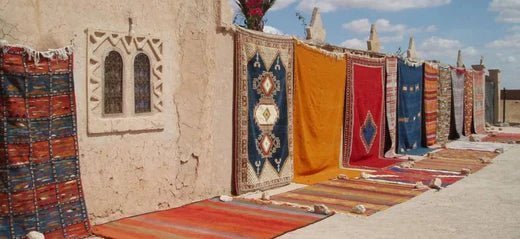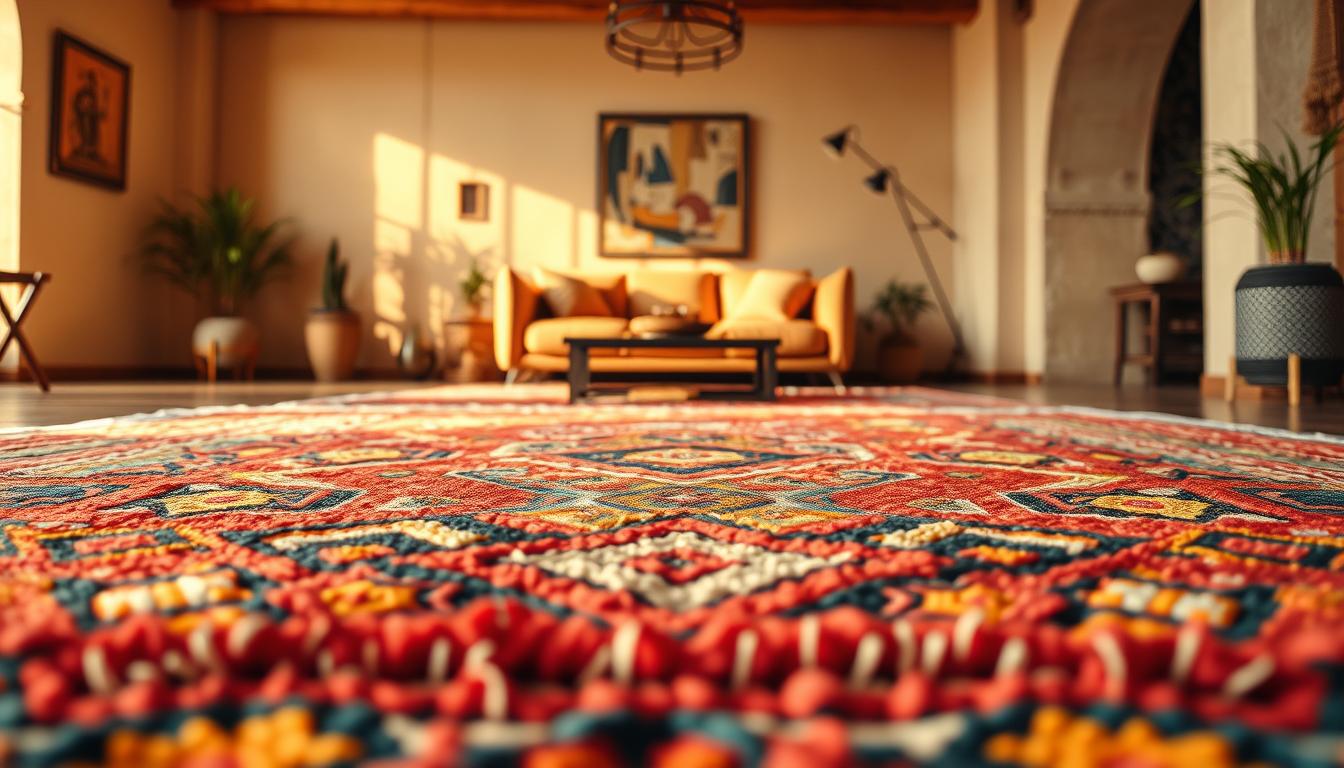
7 Stunning Facts About Moroccan Rugs
Could a simple floor covering hold secrets spanning 14 centuries of human creativity? The answer lies in the textile traditions of North Africa’s Berber tribes, where every knot and pattern whispers stories older than most nations.

These handwoven treasures emerged in 622 AD as practical solutions for mountain living. Women artisans crafted them as bedding, weather shields, and even ceremonial items. Their geometric motifs aren’t random – they map ancestral journeys and spiritual beliefs, preserved through generations like living heirlooms.
Mid-century design icons like Le Corbusier sparked global fascination by pairing these woolen masterpieces with minimalist furniture. Today, they bridge ancient craftsmanship and modern interiors, offering tactile warmth no machine could replicate.
Discover why collectors prize their imperfections and how proper care techniques preserve their vibrant histories. From royal palaces to your living room, these textiles redefine what functional art truly means.
Key Takeaways
- Originated over 1,400 years ago with Berber tribes in North Africa
- Served as multipurpose items beyond floor coverings
- Patterns encode cultural narratives and personal experiences
- Gained modern fame through 20th-century design movements
- Combine historical significance with contemporary style appeal
Discovering the Allure of Moroccan Rugs
Not just decor, these textiles spark dialogues between ancestral artisans and modern admirers. Their patterns hold codes from mountain villages and desert caravans, blending Islamic symmetry with Mediterranean hues. Mid-century designers recognized their magic – earthy textures softening steel-and-glass interiors became an instant design revolution.
Overview of Cultural Impact
Three continents shaped this craft. Spanish mosaics whisper in diamond motifs, French floral touches emerge in border details, while Berber symbols map sacred landscapes. Each piece becomes a cultural passport – you don’t just own a floor covering, you host generations of wisdom.
Timeless Aesthetic Appeal
What makes these creations eternally fresh? Their genius lies in contrast. Bold geometries play against irregular edges, natural indigo meets sun-bleached ivory. They anchor boho lofts as effortlessly as they warm minimalist offices. Your space gains depth without losing modernity – a trick only handcrafted art achieves.
What is a Moroccan Rug?
Beneath your feet lies a woven chronicle of traditions perfected over generations. These textile creations from North Africa combine Atlas Mountain wool with ancestral techniques, resulting in surfaces so plush they redefine comfort. Skilled artisans transform raw fleece into dense piles using methods unchanged since medieval times.

Every piece tells dual stories. Geometric patterns mirror desert landscapes and sacred symbols, while irregular edges reveal human hands at work. Natural dyes from pomegranate and indigo create earthy hues that soften modern spaces. Unlike mass-produced alternatives, no two items share identical designs.
Women from Berber tribes dominate this craft, encoding family histories into knotwork. A diamond might symbolize protection, while zigzags trace migration routes. These visual languages turn functional items into heirlooms, blending daily use with cultural preservation.
| Feature | Traditional Rugs | Modern Adaptations |
|---|---|---|
| Material | Undyed mountain wool | Blended fibers for durability |
| Pattern Purpose | Spiritual protection markers | Abstract decorative elements |
| Production Time | 3-6 months (hand-spun) | 2-4 weeks (machine-assisted) |
Contemporary interiors embrace these textiles for their warmth and authenticity. Designers prize how relaxing colors offset sleek furniture, creating balanced rooms. Whether placed in lofts or country homes, they anchor spaces with tactile history no factory could replicate.
Rich History and Cultural Significance of Moroccan Rugs
In the shadow of the Atlas Mountains, a silent language of wool and dye has spoken across generations. Since 622 AD, Berber tribes have transformed raw fleece into coded narratives – textiles serving as maps, diaries, and spiritual shields long before becoming decor.
Berber Heritage and Tribal Narratives
Young girls learned weaving through their mothers’ hands, memorizing patterns that traced migration routes across North Africa. These living archives carried family histories – diamond motifs warded off evil, while zigzag borders marked sacred water sources. Eastern tribes like Beni Ourain turned domestic crafts into prestige symbols, their ivory-and-charcoal creations becoming currency among elites.
Nomadic life shaped every design choice. Portable sizes fit camel caravans, dense piles insulated against mountain cold, and abstract symbols communicated across dialects. Women artisans encoded their worldviews into tactile stories, making each piece a cultural fingerprint.
Evolution Through the Ages
From palace floors to global showrooms, these textiles adapted without losing their soul. 20th-century demand transformed some tribal practices into specialized trades, yet traditional methods persist. Natural dyes still stain fingertips in remote villages, and symbolic patterns remain unchanged for 40 generations.
Modern collectors don’t just acquire decor – they preserve cultural DNA. The same stitches that once warmed desert tents now anchor Manhattan lofts, proving timeless design transcends eras. Through wars, droughts, and technological revolutions, the stories in wool endure.
Diverse Styles and Iconic Designs
North Africa’s weaving traditions reveal their full splendor through three distinct rug categories. Each style carries regional fingerprints – from mountain villages to urban workshops – proving craftsmanship adapts without losing authenticity.
Beni Ourain, Azilal, and Boucherouite
Beni Ourain creations stand out with their ivory wool fields and charcoal diamond lattices. Crafted by 17 Berber tribes, these pieces mirror snow-capped Atlas peaks through minimalist geometric patterns. Their cream-colored bases absorb sunlight, while subtle brown accents echo henna-stained hands that weave them.
Azilal designs burst with confetti-like energy. Artisans from high-altitude villages blend ochre, cobalt, and saffron dyes into abstract patterns resembling cave paintings. Irregular shapes document personal milestones – a crimson swirl might celebrate a wedding, while zigzag lines trace harvest cycles.
Boucherouite rugs rewrite sustainability rules. Born from fabric scraps, these vibrant mosaics turn discarded textiles into eye-catching statements. Their kaleidoscopic colors defy traditional palettes, proving innovation thrives within cultural boundaries.
Geometric Patterns and Symbolic Motifs
Every line in Moroccan style rugs serves dual purposes. Triangles symbolize mountain peaks, while ladder motifs represent spiritual ascension. These visual codes create protective barriers against misfortune, woven into designs that balance aesthetic appeal with ancestral wisdom.
Contemporary interiors gain depth through these timeless geometric patterns. Designers pair angular motifs with curved furniture, letting ancient symbols soften modern spaces. Whether displayed in lofts or studios, these textiles spark conversations about heritage meeting innovation.
The Art of Weaving and Dyeing
Every thread tells two stories – one of earth’s raw gifts, another of human mastery. The journey begins with Atlas Mountain sheep, whose thick coats provide premium wool ideal for weaving. Herders shear these animals seasonally, ensuring fibers retain natural oils for durability.
Traditional Knotting Techniques
Artisans transform raw wool through meticulous steps. First, they wash fleece in mountain streams, removing debris without harsh chemicals. Hand-spinning follows – twisting fibers into yarn using drop spindles. This slow process creates uneven textures that machines can’t replicate.
The Berber knot defines authentic craftsmanship. Unlike symmetrical Turkish or Persian knots, this technique creates plush piles through irregular loops. Weavers tie each knot by hands, building density that withstands decades of use. One square foot can contain 900 knots – a testament to patience.
Natural Materials and Handmade Processes
Dye masters use ingredients like saffron petals and iron-rich clay. A single color might require:
- Three days of simmering pomegranate rinds
- Crushed indigo leaves fermented in clay pots
- Walnut shells boiled with sea salt
| Aspect | Traditional Method | Modern Approach |
|---|---|---|
| Wool Preparation | Hand-carded fibers | Machine-cleaned batches |
| Dye Sources | Plant-based pigments | Synthetic colorants |
| Weaving Time | 4-9 months | 2-6 weeks |
These authentic wool creations carry imperfections that reveal their handmade soul. A skipped stitch might mark a weaver’s prayer break, while color shifts echo seasonal dye batches. As one artisan notes: “Our rugs breathe – they’re alive with the land’s memory.”
Judging Quality: Craftsmanship and Materials
Your fingertips brush against history when evaluating genuine craftsmanship. Superior materials begin with Atlas Mountain sheep – their wool grows thicker to withstand extreme temperatures, creating fibers that naturally repel dust while maintaining plush softness.

Premium Wool and Mohair Selection
Authentic pieces use undyed wool from free-grazing herds. Look for strands with slight curl – this springiness indicates resilience against flattening. High-grade wool maintains its luster for decades, unlike synthetic blends that dull within years.
| Feature | Authentic Materials | Imitation Indicators |
|---|---|---|
| Fiber Source | Atlas Mountain sheep | Acrylic blends |
| Texture | Buttery soft with natural oils | Plastic-like smoothness |
| Durability | Improves with gentle use | Pills within months |
Indicators of Artisanal Excellence
Perfect imperfections reveal human hands. Slight pattern shifts show where weavers adjusted for wool thickness – a quality control step machines skip. Authentic Moroccan rugs display intentional "flaws" like staggered edges, proving no templates were used.
Test colorfastness by rubbing a white cloth on the surface. Traditional dyes leave no residue – synthetic pigments stain immediately. For lasting vibrancy, choose rugs made from premium wool processed with plant-based mordants rather than chemical fixatives.
Elevating Your Space with Moroccan Rugs
Transform your living area into a canvas where history meets contemporary flair. Moroccan-style rugs act as bridges between eras, their bold patterns energizing modern layouts while honoring ancestral craftsmanship. For balanced design, pair vibrant pieces with minimalist furniture – let the textile become your room’s focal point.
Harmonizing Contrasts
Low-profile couches and streamlined tables create ideal foundations. Choose furnishings 5 inches shorter than standard heights to emphasize vertical space. Neutral upholstery allows intricate Moroccan-style rugs to shine without visual competition.
Layer smaller rugs over larger jute bases for texture play. This technique adds depth while protecting delicate weaves. Explore the boho-chic aesthetic by mixing geometric motifs with macramé wall hangings or terracotta pots.
In open-concept areas, use these textiles to define zones. A bold piece under dining sets anchors the space, while softer patterns in seating areas encourage relaxation. Every placement decision should celebrate both heritage and innovation.
FAQ
How do Berber tribes influence rug designs?
Berber tribes in the Atlas Mountains weave symbolic motifs into rugs, reflecting their heritage. Geometric patterns often tell ancestral stories or represent natural elements like mountains and rivers.
What materials are used to create authentic pieces?
Artisans use undyed wool from local sheep, mohair, or recycled fabrics. Natural dyes from saffron, henna, or indigo add vibrant colors while maintaining eco-friendly practices.
Why do Beni Ourain rugs stand out?
Beni Ourain styles feature ivory backgrounds with bold black geometric designs. These plush, high-pile rugs from the Middle Atlas region balance minimalism and warmth, ideal for modern interiors.
How can you identify premium craftsmanship?
Tight knots per inch, even weaving, and balanced symmetry signal quality. Hand-spun wool fibers and organic dye consistency also highlight artisanal excellence.
Can these rugs complement contemporary decor?
Yes! Their timeless aesthetic pairs well with minimalist or eclectic styles. Layer a Boucherouite rug under sleek furniture or hang an Azilal piece as textured wall art.
What makes weaving a cultural tradition?
For Berber women, weaving preserves tribal identity. Techniques passed through generations transform wool into functional art, embedding each piece with cultural narratives.
How long does it take to make one rug?
Depending on size and complexity, weaving can take weeks to months. Larger pieces with intricate patterns require meticulous handwork, often involving multiple artisans.
Are natural dyes colorfast over time?
When properly cured, plant-based dyes retain richness for decades. Sunlight exposure may soften hues, adding a desirable vintage patina to older rugs.
Where can you find authentic Moroccan-style rugs?
Seek fair-trade cooperatives in regions like Marrakech or the High Atlas. Reputable global retailers like Etsy or Maison Berger also source directly from weavers.









